#velvet top fungus
Text
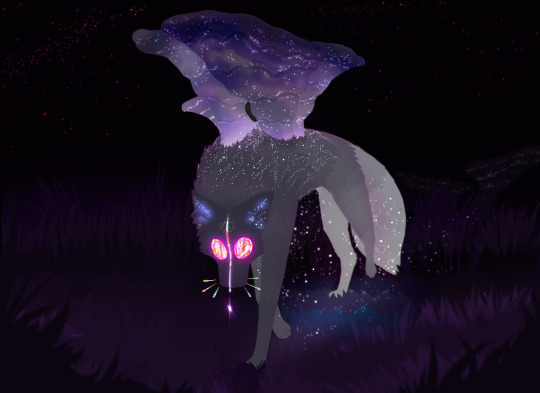
The Dyer Wolf
#The mushroom on top is based on a photo I took of a Dyer's Polypore we found about a month ago#Honestly real proud of the pun#but as usual I set up the pun without realizing it and Carver or Haz spotted it before I did#I post my mushroom photos to Bluesky (dogstomp)#mushroom#wolf#art#dyer's polypore#dyer's mazegill#velvet top fungus#fantasy art#fantasy#fungus#animals
183 notes
·
View notes
Text
holy shit you guys, look, there's more.
bg3 culinary headcanons: Absolute Edition
- Minthara: would accidentally fit in as the Addams Family home chef (and be angry about it). Gomez would praise her assassination attempts which flusters her (internally) because she's cooking with the normal amount of poisonous mushroom and not an attempted murder amount (and also she would hate loud, in-your-face-chaotic Gomez SO MUCH. if she wanted him dead, he would be dead, do not insult her assassinating abilities). makes the coolest Halloween party food until you realize it's not fun, spooky-mimicry decoration, those are real black widows on those cupcakes (what? they're venom and merlot flavored) (she used cricket flour, too). you don't know where she gets the "red" for her red velvet cakes, but you *do* know that ignorance is bliss and this is a pretty bitchin' birthday cake, so don't think too hard and just eat it
- Dark Urge (pre-game/embrace): slaughterhouse nightmare aesthetic - chef's apron is leather and something more appropriate for blacksmithing, there are way too many cleavers around (why in the blue fuck is there a meat hook over a drain in the floor?). some people watch tv when they cook. some listen to music, podcasts, or nothing. Durge listens to the Toy Box killer kidnapping tape (not to be mixed up with the (not safe for LIFE) Tool Box killers torture tape. that one is for relaxing baths). watches Dahmer documentaries for culinary inspiration. Hannibal Lecter would find most Durge dishes tasteless and over the top.
- Ketheric: listen, he didn't want me to tell you this [so you did NOT hear it from me], but he actually doesn't eat. he has a symbiotic relationship with the bacteria and fungus that keep his body animated and undying (they're why his blood is black). he consumes rotten things to keep his corpse puppet fungus happy and the corpse puppet fungus allows him to keep his consciousness/sentience and keep serving Myrkul. Myrkul's cool with it, as long as his bidding continues to get done
- Orin: Martha Stewart would have a nervous breakdown upon entering Orin's kitchen. the average person would consider Orin's cooking to be a hate crime. if someone doesn't vomit uncontrollably upon first sight, she considers it an insult (she grew up with a gross misunderstanding of what a Roman vomitorium is). her spaghetti and meatballs is wrapping a handful of uncooked noodles in unseasoned ground meat (she neither knows nor cares whether it's fish or chicken or cow. meat is meat), then baking it in a casserole dish sprinkled with still-condensed tomato soup from a can. Midwestern casserole cooking brought to you by Hell. doesn't use salt because she finds it too spicy. she has an entire pantry section for savory jello
- Gortash: culinary techbro. kitchen is spilling over with unitasker gadgets ("and THIS contraption evenly distributes heat for the perfect boiled egg! what do you mean 'what else does it do'. it boils eggs perfectly i already told you, why the fuck weren't you listening"), and the most stupid, overengineered 'smart' devices ("no no no, you don't understand, this is so helpful. the fork connects to the plate to measure the temperature of the food, and then the plate changes color to warn me if it's too hot, and then i don't burn my tongue, because i really hate that"). despite all of the pricey kitchen shit that he keeps buying, he's skilled at making exactly one dish: microwaved Totino's pizza rolls
(i'm sorry if Gortash is out of character; my brain replaced his voice with John Oliver's and won't put the original back)
if you want more bg3 culinary headcanons, there's also: the Companion Edition
#soldat buck wrote something#bg3 minthara#minthara#minthara baenre#bg3 ketheric#ketheric thorm#bg3 dark urge#bg3 durge#durge#dark urge#bg3 orin#orin the red#enver gortash#bg3 gortash#bg3#baldur's gate 3#baldurs gate 3#culinary headcanons#bg3 culinary headcanons#i should've made this a separate post in the first place#oops lol#bg3 hcs#bg3 headcanons#the dead three
31 notes
·
View notes
Note
What fungus would you most like to find someday? Why that one?
- ⚠️
ooohh !! i'd really love to find a blue mushroom / fungus. any sort :-) i've never seen a blue mushroom but i believe i've found every other colour. (even purple & green<3)
my top picks would be pixie's parasol, sky blue mushroom, or velvet blue spread !! (links lead to my FOTDs about them)
none of these are in my country, though.. but maybe i'll find something similar to them :-)
8 notes
·
View notes
Text
Fascinating Fungi & Their on/off Friendship with Trees
Tree fungi are a diverse group of organisms that play important ecological roles in forest ecosystems. They are a crucial component of the forest ecosystem, as they decompose dead organic matter, recycle nutrients, and form symbiotic relationships with living trees.
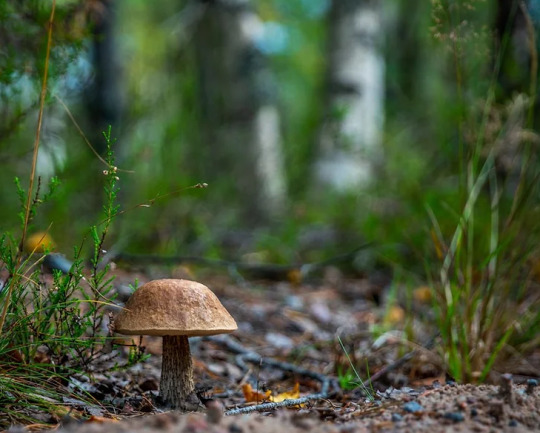
In this blog, we will explore the fascinating world of tree fungi and their impact on our environment!
Fungi are vital to our forest eco-systems, the are the decomposers, without fungi everything that has ever died would still be there...whole. It is mad to think just how much we take them for granted!
Fungi are eukaryotic organisms that are essential for decomposing organic matter in the environment. Fungi are one of the most diverse groups of organisms on the planet, with over 100,000 known species. They are found in almost every environment, from the depths of the ocean to the tops of mountains. Fungi are divided into two main categories: macroscopic fungi, which produce visible fruiting bodies like mushrooms and toadstools, and microscopic fungi, which do not produce visible fruiting bodies and are commonly referred to as molds or mildews.
Tree fungi are a type of macroscopic fungi that grow on or within trees. They can be beneficial or harmful to the tree, depending on the type of fungi and the severity of the infection. Some tree fungi form mutualistic relationships with the tree and help it to absorb nutrients from the soil. Others cause damage to the tree by weakening its structure or by causing rot.
One of the most common types of tree fungi is the bracket fungi, this includes common fungi such as Hoof Fungus (Fomes Fomentarius), the Velvet-top Fungus (Phaeolus suchweinitzii) or any of the Ganoderma species (such as Artists' fungus) . These fungi grow on the trunks or branches of trees, forming large, shelf-like structures that can be several feet across. They are often seen on dead or dying trees, where they play an important role in the process of decomposition.
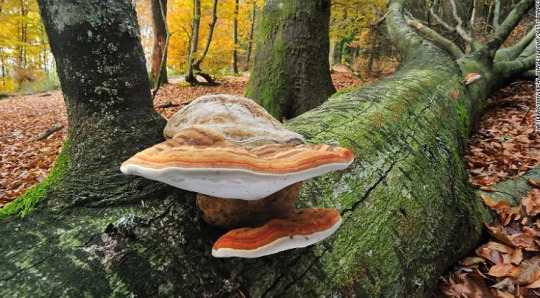
Fomes Fomentarius or 'hoof fungus', a bracket fungi that causes decay nf rot in the heartwood of trees.
Another type of tree fungus is the Armillaria root rot fungus, which is commonly known as the honey fungus. This type of fungi attacks the roots of trees and can cause them to become weak and eventually die. The honey fungus is particularly damaging to fruit trees and can lead to significant crop losses.

Armillaria mellea or 'honey fungus'. Honey fungus spreads underground, attacking and killing the roots of perennial plants and then decaying the dead wood. It is the most destructive fungal disease in UK gardens.
Another common type of tree fungi is the mycorrhizal fungi. Mycorrhizal fungi help the tree to absorb nutrients from the soil, particularly phosphorus and nitrogen. In exchange, the tree provides the fungi with sugars and other nutrients that it produces through photosynthesis. This mutualistic relationship is essential for the health and growth of many trees. This relationship is so important that it is estimated that over 90% of all tree species rely on mycorrhizal fungi for their survival.
Tree fungi also play a vital role in the cycling of nutrients in the forest ecosystem. They break down dead organic matter, releasing nutrients back into the soil where they can be taken up by living trees. This process is essential for the health of the forest ecosystem, as it ensures that nutrients are constantly being recycled and made available to living organisms.

Mycorrhizae- the tiny white roots that make a huge difference to your tree/plant/shrub's health!
Despite their importance in the forest ecosystem, tree fungi are often overlooked by people. Many people see them as unsightly or even dangerous, as some species of tree fungi can cause decay in the wood of living trees. However, the vast majority of tree fungi are harmless, and that they play a vital role in the health and functioning of the forest ecosystem.
It is important to remember that tree fungi are an essential part of our environment, but they can also be harmful to trees if they are not properly managed. If you suspect that your tree is infected with a fungus, it is essential to contact a professional arborist who can diagnose the problem and recommend the appropriate treatment. Regular tree care, including pruning and fertilization, can also help to prevent fungal infections and keep your trees healthy and strong.

Image from a recent CPD course we undertook in tree inspection, with a primary focus on identifying fungi.
Check out the giant brackets of Ganoderma!
In conclusion, tree fungi are a diverse and important group of organisms that play crucial ecological roles in forest ecosystems. They decompose dead organic matter, recycle nutrients, and form symbiotic relationships with living trees. Although they are often overlooked, they are essential for the health and functioning of the forest ecosystem, and should be appreciated and protected. If you have trees on your property, it is essential to be aware of the signs of fungal infections and to take appropriate steps to manage them.
By working with a professional arborist and practicing regular tree care, you can help to ensure that your trees remain healthy and strong for years to come.
0 notes
Text
Why is Black Mold In Brita Pitcher? | And how to Prevent?
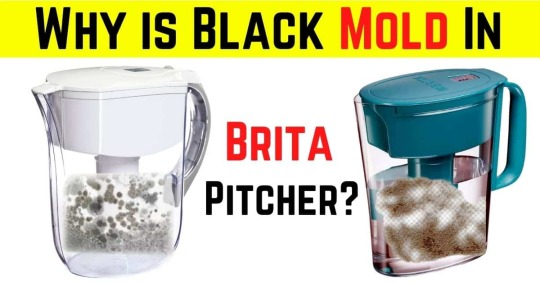
It may be shocking for everyone to assume that there is black mold in your Brita pitcher.
After all, it provides healthy, tasty, and clean water in a bacteria-free environment in the fridge.
Although, indeed, anything exposed to human usage and water would quickly get untidy.
One day I noticed smudges, yes! It is a Shocking mold!
Mold could grow in water filters, but there would need to be some organic material around for the mold spores to grow on.
According to the report of the Berkeley National Laboratory 2007, in the U.S., approximately 4.6 (2.7-6.3) million cases are reported to have asthma due to attributable to dampness and mold exposure in the home.
The Brita product is effective we use daily and whose cleanliness affects our health. So, it should wash regularly.
There are apparent explanations below; let's go through them in detail.
What are molds and mildews?
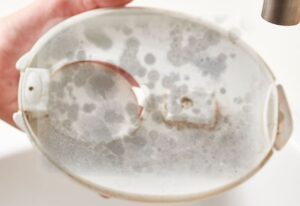
Maybe you may have noticed this green mold in Brita pitcher growing around the brim of our utensils. Many of us can't elaborate on what they are.
These are the most headstrong bacteria that always manage to grow around us. As unwanted as these ubiquitous microbes are, it becomes even harder to eliminate them from our homes forever.
You can call them the top species, given how simply these bacteria can survive and breed in any environment.
It is easy for them to grow in suitable areas, which makes it difficult to destroy them forever.
If these bacteria are not removed quickly, they can seriously harm the longevity of the host property.
In addition to being slimy, disgusting mites, mold, and mildew can also threaten the host's structural well-being.
Brita filter claims to purify your water, and Brita can't remove Coliform Bacteria, Fungus, Viruses, Fluoride, and Arsenic.
Let us consider the main difference between mold and mildew in more depth.
What is black mold & Mildew in Brita pitcher?

The activated carbon property of the charcoal in Brita products will do nothing to cause any mold to grow around it. Even if there are some traces of organic material.
Molding spores can't grow on activated carbon. What you are looking at is black mold on the Brita filter pitcher. It is a form of mold that only grows in a bio-film or a relatively narrow habitat.
Which is equivalent to a 2-inch weed-covered patch of ground. The mold grows in the narrow habitat, not in the larger environment or surrounding space.
It was first known as a mold because it looks like mold, which appears black on a white object.
Here is a chart showing the types of mold (swipe right to see all the information).
MoldClassificationTypeLook likeInfection signsGrow inPenicillinAllergenicGreenBlue-green, velvet texturePulmonary infection, sinusitisCarpets, WallpaperAlternariaAllergenicGreenVelvetAsthma-like symptomsSinks, tubs, showersCladosporiumAllergenicGreenOlive green feels like suedeEye and skin allergiesInside cupboards, fabric, upholsteryAspergillusAllergenicGreenLight-green/yellow circular patchesAsthma attacks, lung infectionsThroughout the houseSerratia marcescens (bacteria)Allergenic + pathogenic (causes disease)PinkPink film coating waterBloodstream infections, pneumonia, respiratory infectionsSink, toilet bowl, water-logged areas like bathtubsChaetomiumAllergenicBlackBlack, fluffy like cotton candySkin and nail infectionsWater-damaged structures and pipesAureobasidiumAllergenicBlackBlack patchesSkin irritationWooden surfaces, wallpaperUlocladiumAllergenicBlackBlack stripsSkin infections, hay feverKitchen and water-damaged areasStachybotrysAllergenic + toxigenicBlackBlack, slimyBody ache burning eyes, depressionDamp areas, wood, cardboard
Read our comprehensive review of the
- 10 Best Alkaline Water Pitchers 2023 Edition
- 10 Best Glass Water Filter Pitchers
- Best Copper Pitchers
Difference between molds and mildews
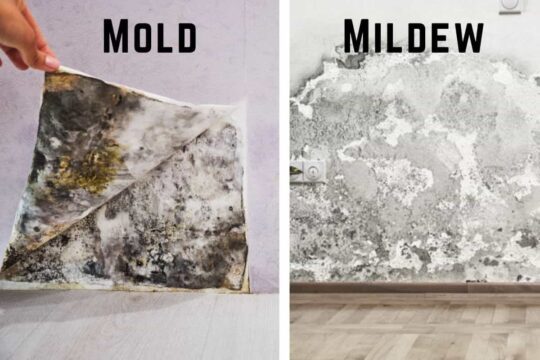
The main difference between mold and mildew
Molds are categorized as fungi that have multiple identical nuclei.
These bacteria can see in greenish and blackish colors. However, mildew is nothing but a particular subspecies of molds.
Now, mainly molds are a dangerous threat because they are identified to plunge into the surfaces of things and decide to grow deeper into them.
The risk of mildew is slightly lower as they only survive and breed in flat areas and can be easily eradicated.
You can easily find mold on old walls, cracks, surprisingly on food, and sometimes in Brita water filter pitchers.
However, it grows in wet areas such as organic materials, paper, plastic, etc.
Different types of mold
To be clear, it's probably impossible to identify every type of mold because those growing indoors have already exceeded 10,000 variants.
Some of the most common types of mold are listed below.
Aspergillus
It is the most common mold category and is most likely the one you often see in your Brita water bottle filter.
These bacteria are usually seen in brown, shades of green or black and can pose inflammation of the lungs.
Cladosporium
This type of fungus is usually developing at cool temperatures. It can cause several mild respiratory issues.
Penicillium
This type of fungus increase often in materials that are in high contact with water. It can cause severe allergic reactions if exposed to the human body for a long time.
Alternaria
It grows under kitchen/bathroom sinks, walls, showers, or similarly damp areas. That can lead to asthma.
Common mildew types
Mildew is a plant-related disease that can harm trees and is divided into two main types.
Powdery mildew
These fungi are generally found in white patches and harm growing crops.
Downy mildew
It is found widely in agricultural products. These fungi are initially yellow and later turn brown.
It is more dangerous than your old filter stopped working due to clogging, further explored in these articles:
- 15 Reasons Why Brita Longlast Filter is Slow?
- 10 Reasons Why Do Zero Water Filters Slow?
The dangers of drinking moldy water

Here is a question that arises in my mind can mold in Brita make you sick?
Short-term mold exposure has no severe health risks except for specific allergies. But, According to a study by the National Institutes of Health, Infants, toddlers, and children may be particularly at risk.
Mold effects also depend on the person and his health from exposure. Some people can be sensitive to mold exposure, while others have a light effect.
Here is some common sense of drinking moldy water from a Brita pitcher:
- Acute liver disease
- Diarrhea
- Vomiting
- Throat irritation
- Persistent coughing
- Persistent headaches
- Wheezing
- Several mild respiratory issues
- Asthma
- Pose inflammation of the lungs
- Nasal stuffiness
- Skin irritation
- Eye irritation
Although your Brita filter works too fast, in spite of this smell moldy, it could be more harmful to those who suffer from mold allergies.
Mold could be dangerous because it's likely to harbor chemicals, bacteria, and harmful gasses.
Over a long-term period, use may cause fungal infections like athlete's foot and thrush when exposed to dangerous strains of mold spores.
So, avoid drinking moldy water to keep you protected from the risk of diseases.
How to identify black mold in your Brita water pitcher?

Brita is a famous brand for making alkaline water, but mold can affect its performance.
It is characterized by the same brown splotches which can appear on other types of mold. These may look similar to brown scales on a dish, mainly stainless steel.
Along with black mold, you may also see fine, clear, black, or brown scales that make a solid visible glow under a lens.
They are web-like networks of unrecompensed organic material like organic cotton or a plant-like mass from a tree.
Black mold can be a risk. If mold is growing, the environmental conditions of your home.
However, it could be in your filtered water if the mold on top of the Brita pitcher indicates that you have not yet cleaned your jug.
Clean your tap water pitcher properly to keep you safe from its effects.
How to Prevent Mold in Brita Pitcher?
Among the different ways to prevent mold and mildew from growing in your home, the most effective way is to keep all home surfaces clean, dry, and moisture-free.
Ensure that the room temperature doesn't exceed 40-50 degrees, which can help lower its growing chances.
Keep your home humidity level under 40% to 50%, and you can use a Dehumidifier to maintain a certain level.
Inspect heating and cooling systems in the home constantly, maintain the proper airflow in the house, and fix leaks wherever.
Prevent Mold With White Vinegar
Last but not least, white vinegar is the best option for cleaning up stubborn mildew development in your home or tap water pitcher.
Generally, it is advisable that when you notice any mildew-infested plants, you should take them out of your house to stop any mildew infestations.
I understand that the molds are not what you want growing in your Brita pitcher. And also, the quality of your drinking water may surely drop.
How to Clean Brita Pitcher to prevent black mold?
Cleaning a dirty Brita filter pitcher is easy as washing any other kitchen dish you need is the desire to take hygiene to the next level.
Things you need:-
- Water
- Measuring cups
- Sponge
- White vinegar
- Drying rack or a dish towel
- New filter
Steps for Cleaning a Brita Water Pitcher.
Disassemble the Pitcher

Pour the remaining filtered water, disassemble it, and set the pitcher aside.
You'll have to do that if you do not replace the screen. Disassembling is a bit tricky when you want to wash the inside.
Wash

Create a mixture of dish soap and warm water (avoid extremely hot water and bleach solution). Soak the reservoir and the lid for between 30 to 60 minutes. Then scrub every piece until you are satisfied that they are neat and clean.
Scrub off mildew

After you've cleaned the pieces, it's almost impossible to see the mildew, especially when you wash them thoroughly.
If it is ineffective, mix one teaspoon white vinegar with one cup of tap water in a bowl and then scrub the pieces with this solution.
Rinse and dry

You can hear the squeaking sound when you don't feel any mildew left. Wash both the lid and reservoir in water; Do this well. Alternatively, keep it in warm water (avoid extremely hot water).
Then put them to air dry; To avoid mildew developing in the pitcher, you'll want to ensure each part is arid before putting it back together.
Preparing the new filter
Since the pitcher is left out to dry, it's time to remove the Brita filter. Soaking depends on the brand models of Brita pitcher. The newer versions do not require soaking before washing like the old version.
But before washing, you need to follow the instructions that come with your water filtration product.
Putting the pitcher together

When the pitcher is dry with the new filter, it's time to reassemble. Pour cold water over the pitcher's side and spread afterward to eliminate any remaining carbon particles.
This step should be repeated at least twice to make sure your clean water is carbon-free.
Additional Tips
1. Use a new toothbrush to clean those hard-to-get parts.
2. Avoid using bleach solution if mold is on the bottom of the Brita filter.
3. Replace the Brita longlast filter or standard filter and throw it away if you cannot follow the steps above.
4. Use of the solution is easier to clean Brita pitcher mold rather than soap.
Pink mold in Brita pitcher
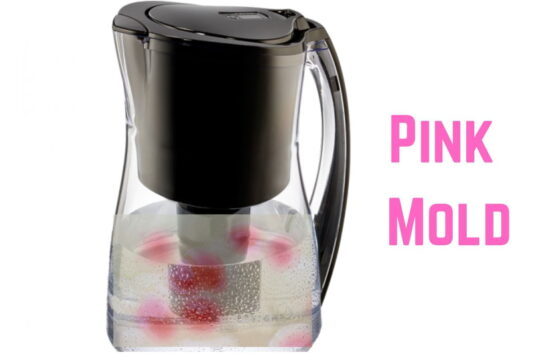
Few Brita customers face pink stains or residues that hardly develop in their Brita water filter pitchers.
It can grow around the sink, tub drains, toilet bowls, shower curtains, and even in pet water bowls.
Users naturally want to understand if something is wrong with their drinking water.
No, a pink deposit is not a problem with your hard water and is not dangerous in this condition.
These are common bacteria in our environment, and the type of these bacteria is recognized as Serratia marcescens.
These bacteria grow in natural sources such as dust, soil, mulch, and surface water, where high phosphate moisture helps to develop.
For example, a pink mold in Brita pitcher frequently develops when dirt and dust containing Serratia enter the pitcher.
Chlorinated drinking water is not suitable to survive Serratia.
It mostly happens in untreated tap water, private groundwater supply, and in the summer when temperatures and humidity are higher.
Using an activated carbon filter, those who eliminate the chlorine smell and other contaminants from their drinking water may have more chances of experiencing pink mold.
How many types of Brita filters are popular in the market?
There are five types of popular Brita filters available in the market:
- Longlast Filter
- Standard Filter
- Stream Filter
- Faucet filter
- Bottle filter
1. Brita Longlast Filter: - Water pitcherfilter removes chlorine, lead, benzene, cadmium, asbestos, and other contaminants, and the filter life is 6 months (every 120 gallons).


2. Brita Standard Filter: - The filter can remove mercury, zinc, chlorine, cadmium, etc. The filter indicator shows the replacement time after 2 months (every 40 gallons). Brita standard filter is affordable compared to bottled water.
3. Brita Stream Filter: - The filter removes dichlorobenzene and chlorine and needs a filter cartridge after 2 months (every 40 gallons). The Brita Stream filter can purify as you pour the cold water.
4. Brita Faucet: - A faucet filter removes lead, chlorine, benzene contaminant, asbestos, particulates, mercury, yellow well water, and TTHMs and replaces after 4 months (every 94 - 100 gallons)
5. Brita Bottle filter: - The filter used in a premium filtering water bottle can provide tasty bottled water by removing particulates, chlorine, dust, and other contaminants. The filter life is 2 months (every 40 gallons). You can keep the Brita bottle filter while traveling outside and get filtered water when you want. There is no filter indicator to know when to change the filter cartridge.
FAQs
Are algae in the Brita filter dangerous? Drinking algae-contaminated tap water is not advised. Although consuming small quantities of algae-contaminated water may not be dangerous, you may experience signs such as vomiting, headache, nausea, diarrhea, rash, and abdominal pain.
Algae-contaminated water in the Brita water bottle filter has not smell and taste good.
The contamination chance of your water filtration with algae can increase when you use water from a private well. Why Do I Need A Brita Water Filter?
Read the full article
0 notes
Photo

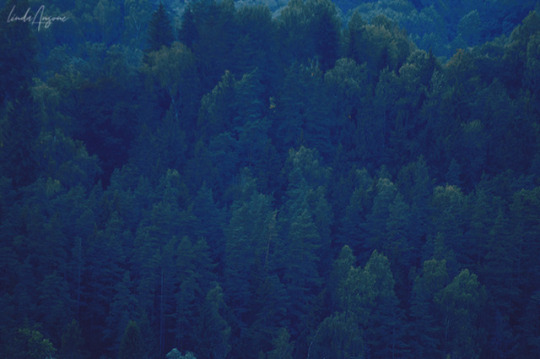

#latvia#mushrooms#fungi#Flammulina velutipes#Collybia velutipes#Velvet Shank#Winter Fungus#Velvet foot#līgatne#forest#fir trees#tree tops#fir tree cones#nature#original photography#original photographers#nikon photography#photographers on tumblr
603 notes
·
View notes
Text
Does it - does it hatch?
I feel like we’re only calling it an egg because it’s going to hatch. But I cannot think of a single thing that could hatch out of it that would not be stupid.
Yet I must try:
dinosaur.
Dream but red. suck it red boiii. hm, does not have the same ring to it
BIG fox.
antfrost’s boyfriend red velvet. What a fuckin character introduction. the buildup
another egg. God. Satan. Korrok. cthulhu. sally the salmon. ostrich. chicken. many chickens. parrot? PARROT BUT IT SAYS DEMONIC THINGS
somebody with creative mode
mumbo jumbo’s walking house - stylized like baba yaga
maybe god is what’s created when enough minds come together as one. Maybe it will reverse hatch and draw everybody into the egg
plant. fungus. ...herobrine. alien. redstone bugs (from the joke update). giant zombie (no AI) RED DRAGON
somehow whatever tf the other half of ranboo is
old netherrack texture. nuke. pink wither from love n hugs. the antagonist of minecraft story mode. Wilbur but wearing armor. a p p l e. chocobo.
the Blood God [blood for]
Addison Rae. cave update. the warden. buff axolotl. the nephilim. those weird carnivorous timeline-infesting crows from the only other book with this premise. the swarm (shitload). fuckroaches. a larval stage?
the Minotaur. Actually regardless of what it is I might call it the Minotaur
beholder. the big tower from lego batman with the eye on top. balrog. BALROG dwarf’s bane the dwarves strip mined too greedily and too deep.
demogorgon. soothouse. new, never-before-seen music disc. aether portal. whatever creature elytras come from. villager. depression given form. the monsters from Bird Box
#dream smp#dream smp theory#mcyt#hyperfixating on block game sorry#help me guys i'm so stuck#the Egg#blood vines#shitposting#from my fanfic planning document
15 notes
·
View notes
Text
Worldbuilding nobody asked for: Star Verse Flora and Fauna.
This is just a list of the stuff, mostly organized. Feel free to send in an ask if you want to know more about something.
Carenian Fire Fir
Sleeproot
Southern Wind Puff
Painted Bramble Berry
Spice Berry
Fire Cherry
Gator Melon
Cloud Top Mushroom
Storm Top Mushroom
Glow Pulse Fungi
Swirl Top Fungus
Northern Blood Flower
Velvet Blood Flower
Broad Leafed White Lace
Pepper Lantern Plant
Ship’s Moss
Green Vase Algae
Salt Lily
Salt Lotus
Stone Tuber
Tropical Surf Flyers
Northern Surf Flyer
Golden Salt Koi
Golden Mudfish
Cloud Whale
Desert Glasswing
Firebird
Tropical Blue Gull
Northern Tree Head
Branch Headed Hare
Rider Squirrel
Dye Colored Mouse
Giant Sandworm
Giant Sun Scorpion
Giant Sun Lizard
Grassmount
Draught Puller
Island Rockhide
Continental Rockhide
Grass Runner
Tropical Surf Flyer
Northern Surf Flyer
Golden Salt Koi
Golden Mudfish
Cloud Whale
Mythological Creatures:
Southern Snowbird
Horses
#star verse: flora#star verse: fauna#worldbuilding nobody asked for#star verse: worldbuilding#star verse: dinosaurs
8 notes
·
View notes
Photo
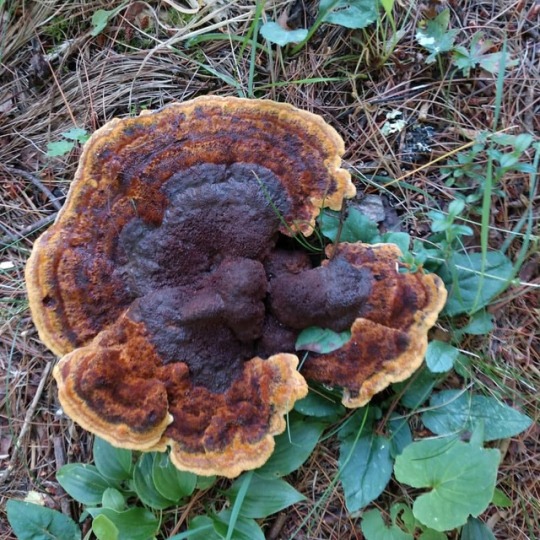
Phaeolus schweinitzii, commonly known as Velvet-top Fungus or Dyer's Polypore - a pathogen on conifer trees. Sure is pretty!!😊 . . . (at Gerton Helipad) https://www.instagram.com/p/B1CrL5dgnud/?igshid=1kfurd1oql31m
6 notes
·
View notes
Text
Lepanto
BY G. K. CHESTERTON
White founts falling in the courts of the sun,
And the Soldan of Byzantium is smiling as they run;
There is laughter like the fountains in that face of all men feared,
It stirs the forest darkness, the darkness of his beard,
It curls the blood-red crescent, the crescent of his lips,
For the inmost sea of all the earth is shaken with his ships.
They have dared the white republics up the capes of Italy,
They have dashed the Adriatic round the Lion of the Sea,
And the Pope has cast his arms abroad for agony and loss,
And called the kings of Christendom for swords about the Cross,
The cold queen of England is looking in the glass;
The shadow of the Valois is yawning at the Mass;
From evening isles fantastical rings faint the Spanish gun,
And the Lord upon the Golden Horn is laughing in the sun.
Dim drums throbbing, in the hills half heard,
Where only on a nameless throne a crownless prince has stirred,
Where, risen from a doubtful seat and half attainted stall,
The last knight of Europe takes weapons from the wall,
The last and lingering troubadour to whom the bird has sung,
That once went singing southward when all the world was young,
In that enormous silence, tiny and unafraid,
Comes up along a winding road the noise of the Crusade.
Strong gongs groaning as the guns boom far,
Don John of Austria is going to the war,
Stiff flags straining in the night-blasts cold
In the gloom black-purple, in the glint old-gold,
Torchlight crimson on the copper kettle-drums,
Then the tuckets, then the trumpets, then the cannon, and he comes.
Don John laughing in the brave beard curled,
Spurning of his stirrups like the thrones of all the world,
Holding his head up for a flag of all the free.
Love-light of Spain—hurrah!
Death-light of Africa!
Don John of Austria
Is riding to the sea.
Mahound is in his paradise above the evening star,
(Don John of Austria is going to the war.)
He moves a mighty turban on the timeless houri’s knees,
His turban that is woven of the sunset and the seas.
He shakes the peacock gardens as he rises from his ease,
And he strides among the tree-tops and is taller than the trees,
And his voice through all the garden is a thunder sent to bring
Black Azrael and Ariel and Ammon on the wing.
Giants and the Genii,
Multiplex of wing and eye,
Whose strong obedience broke the sky
When Solomon was king.
They rush in red and purple from the red clouds of the morn,
From temples where the yellow gods shut up their eyes in scorn;
They rise in green robes roaring from the green hells of the sea
Where fallen skies and evil hues and eyeless creatures be;
On them the sea-valves cluster and the grey sea-forests curl,
Splashed with a splendid sickness, the sickness of the pearl;
They swell in sapphire smoke out of the blue cracks of the ground,—
They gather and they wonder and give worship to Mahound.
And he saith, “Break up the mountains where the hermit-folk can hide,
And sift the red and silver sands lest bone of saint abide,
And chase the Giaours flying night and day, not giving rest,
For that which was our trouble comes again out of the west.
We have set the seal of Solomon on all things under sun,
Of knowledge and of sorrow and endurance of things done,
But a noise is in the mountains, in the mountains, and I know
The voice that shook our palaces—four hundred years ago:
It is he that saith not ‘Kismet’; it is he that knows not Fate ;
It is Richard, it is Raymond, it is Godfrey in the gate!
It is he whose loss is laughter when he counts the wager worth,
Put down your feet upon him, that our peace be on the earth.”
For he heard drums groaning and he heard guns jar,
(Don John of Austria is going to the war.)
Sudden and still—hurrah!
Bolt from Iberia!
Don John of Austria
Is gone by Alcalar.
St. Michael’s on his mountain in the sea-roads of the north
(Don John of Austria is girt and going forth.)
Where the grey seas glitter and the sharp tides shift
And the sea folk labour and the red sails lift.
He shakes his lance of iron and he claps his wings of stone;
The noise is gone through Normandy; the noise is gone alone;
The North is full of tangled things and texts and aching eyes
And dead is all the innocence of anger and surprise,
And Christian killeth Christian in a narrow dusty room,
And Christian dreadeth Christ that hath a newer face of doom,
And Christian hateth Mary that God kissed in Galilee,
But Don John of Austria is riding to the sea.
Don John calling through the blast and the eclipse
Crying with the trumpet, with the trumpet of his lips,
Trumpet that sayeth ha!
Domino gloria!
Don John of Austria
Is shouting to the ships.
King Philip’s in his closet with the Fleece about his neck
(Don John of Austria is armed upon the deck.)
The walls are hung with velvet that is black and soft as sin,
And little dwarfs creep out of it and little dwarfs creep in.
He holds a crystal phial that has colours like the moon,
He touches, and it tingles, and he trembles very soon,
And his face is as a fungus of a leprous white and grey
Like plants in the high houses that are shuttered from the day,
And death is in the phial, and the end of noble work,
But Don John of Austria has fired upon the Turk.
Don John’s hunting, and his hounds have bayed—
Booms away past Italy the rumour of his raid
Gun upon gun, ha! ha!
Gun upon gun, hurrah!
Don John of Austria
Has loosed the cannonade.
The Pope was in his chapel before day or battle broke,
(Don John of Austria is hidden in the smoke.)
The hidden room in man’s house where God sits all the year,
The secret window whence the world looks small and very dear.
He sees as in a mirror on the monstrous twilight sea
The crescent of his cruel ships whose name is mystery;
They fling great shadows foe-wards, making Cross and Castle dark,
They veil the plumèd lions on the galleys of St. Mark;
And above the ships are palaces of brown, black-bearded chiefs,
And below the ships are prisons, where with multitudinous griefs,
Christian captives sick and sunless, all a labouring race repines
Like a race in sunken cities, like a nation in the mines.
They are lost like slaves that sweat, and in the skies of morning hung
The stair-ways of the tallest gods when tyranny was young.
They are countless, voiceless, hopeless as those fallen or fleeing on
Before the high Kings’ horses in the granite of Babylon.
And many a one grows witless in his quiet room in hell
Where a yellow face looks inward through the lattice of his cell,
And he finds his God forgotten, and he seeks no more a sign—
(But Don John of Austria has burst the battle-line!)
Don John pounding from the slaughter-painted poop,
Purpling all the ocean like a bloody pirate’s sloop,
Scarlet running over on the silvers and the golds,
Breaking of the hatches up and bursting of the holds,
Thronging of the thousands up that labour under sea
White for bliss and blind for sun and stunned for liberty.
Vivat Hispania!
Domino Gloria!
Don John of Austria
Has set his people free!
Cervantes on his galley sets the sword back in the sheath
(Don John of Austria rides homeward with a wreath.)
And he sees across a weary land a straggling road in Spain,
Up which a lean and foolish knight forever rides in vain,
And he smiles, but not as Sultans smile, and settles back the blade....
(But Don John of Austria rides home from the Crusade.)

#gk chesterton#classic#spiritual poetry#poem#poerty#english poetry#english writer#courage#histroy#middle ages#chritianity#Islam#catholicism#warfare#wars#europe#battle#war poetry#miguel de cervantes#Don John of Austria#crusades#don quijote de la mancha#malta#byzantium
1 note
·
View note
Photo
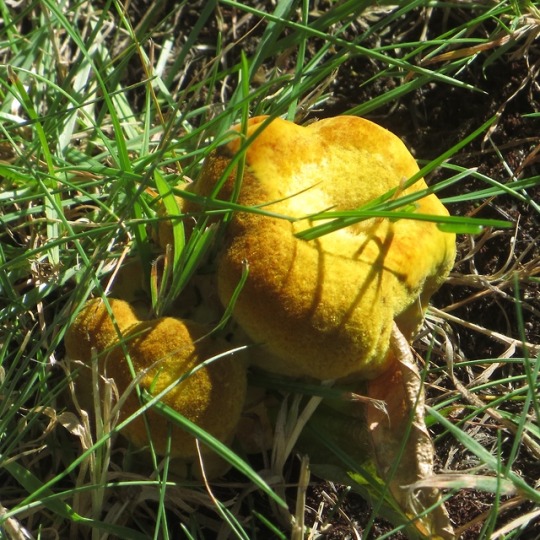
Kiefern- oder Nadelholz-Braunporling | Velvet-top fungus, dyer’s polypore, or dyer’s mazegill
Phaeolus schweinitzii
#KiefernBraunporling#NadelholzBraunporling#Velvettopfungus#Dyerspolypore#Dyersmazegill#Phaeolusschweinitzii#Pilz#Mushroom
3 notes
·
View notes
Text
At some point, I'd like to get some more plants for my terrarium... and isopods. i keep telling myself that if i leave, it's not gonna work out and they will all die, but...
it's been over 2 years already and we're already a quarter through '22. legit, the only reason I'd want to stay is because of my little indoor garden and the possibility of cute little living things I'd have to care for.
I went to Lowes and they have nothing, but an alocasia Polly corm did happen to fall into my pocket. how did it get there? who knows. they're tricky things. i hope it sprouts so i can add it to the pot, especially since the root rotted one doesn't seem to be doing great. the new leaf has definitely aborted so now it's just stagnant. i don't know if it will grow a new growth point or die back all together and start over. The leaf on the other one is growing fine and it looks like it will keep all 4 leaves.
The other corms are doing well, and i condensed them into 2 pots because I'm running out of room. The Black Velvet corm is doing amazing out of the bunch . speaking of which, the new leaf on the mature plant is still unfurling. it looks like it will be fairly large. the flower looks like it may open up quicker than the Bambino so that may be where i get my pollen from. ive looked up quite a lot on alocasia pollination between til tok and YouTube and some info is contradictory, mostly having to do with when the ovum is receptive to receiving pollen. all i know is that there is a small window of time... just not quite sure on when that window is.
The Maharani is starting to spread out a bit and the new leaves are still unfurling. one leaf is starting to yellow, but, i mean,all things considered, it's not too bad.
Ever since i repotted the Silver Dragon, it's been growing taller and stronger. The newest leaf on the Dragon Scale is getting larger, and the Nebula is still giving me nothing, but i finally decided to cut the leaf that i thought was dying because i have a feeling it might have been a fungus.
The Cuprea is slowly starting to lose the 2nd leaf and i don't know whether to cut the leaf to help it safe energy, or let it stay in order to pull energy from it and help it photosynthesis. I may just leave it be. i took a quick peek at the roots on Sunday, about a week after putting it in moss, and there are two roots and lots of little root nubs, as well as a small growth point that i can't quite tell if it's a new root or offshoot.
The Adansonii is steadily growing and i think I'm going to make a point not to move it much within the pot so i don't disturb the roots because pulling it out and putting it back causes me to sometimes have the pot sitting on top of new roots and crushing them.
and my Deliciosa is starting to unfurl both leaves. doesn't look to have any fenestrations, but they both seem fairly large. they both count as, i believe, the 3rd or 4th leaf on each stem and I've read not to expect any fenestrations until at least the 5th or 6th.
0 notes
Text
Rations for various RPG Races
[[ Source. Original creator: wats6831. Additional information and images linked under each one. Love this project? Support it here! ]]
Universal:
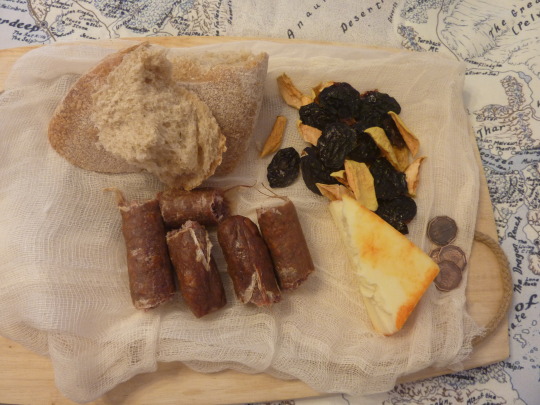
Homemade artisan herb bread, home grown and dried apples and prunes, uncured beef sausage, munster cheese. Made a small bag from cheesecloth and tied it closed.
Discussion thread here.
Human:

Waterdhavian oat loaf (handmade irish soda bread, fresh smoked ham shank, "dessert" pear, Corm Orp "mountain" bleu cheese served on butternut squash, imported Saerloon broccoflower (Romanesco), mixed garden vegetables (carrots and radishes), Misty Forest chestnuts.
More images here. Discussion thread here.
Dwarf:

Garlic chicken livers, smoked and peppered cheese, spiced pork sausages, hard tack, dried vegetables, dried wild mushrooms.
Discussion thread here.
Elf:

Top left to right: Evereskan Honey Comb, Elven Travel Bread (Amaretto Liquer Cake with custom swirls), Lurien Spring Cheese (goat cheese with garlic, salt, spices and shallots), Delimbyr Vale Smoked Silverfin (Salmon), Honey Spiced Lichen (Kale Chips), and Silverwood Pine Nuts.
Discussion thread here.
Halfling:
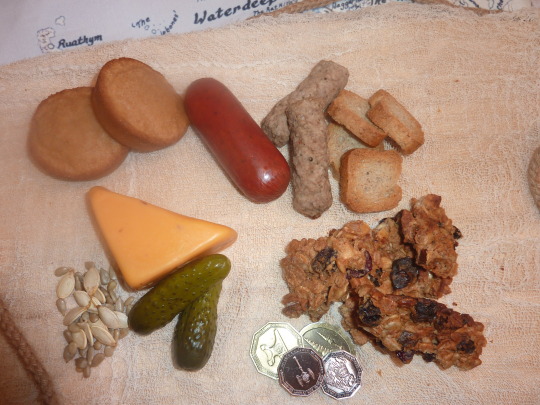
From upper left: "Honeytack" Hard tack honey cakes, beef sausage, pork sausage mini links, mini whole wheat toast, cranberry cheddar cheese mini wedge, mini pickles, pumpkin and sunflower seeds, lower right is my homemade "travel cake" muesli with raisins, golden prunes, honey, eggs and cream.
Discussion thread here.
Half-Orc:

Wrapped in cheesecloth and tied in burlap package. Forest strider drumsticks, molasses sweet wheat bread "black strap", aged Munster, hard boiled eggs, mixed wild nuts.
Discussion thread here.
Orc:
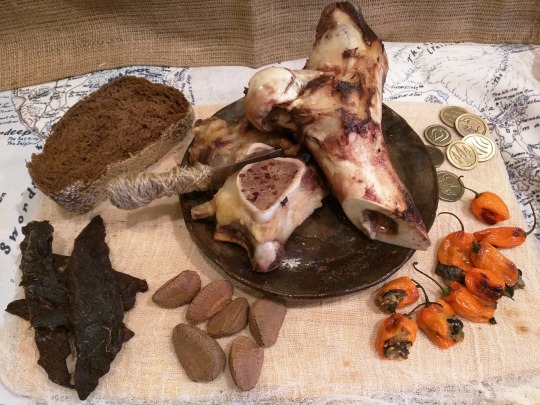
Orcs aren't known for their great cuisine. Orcs prefer foods that are readily available (whatever can be had by raiding), and portable with little preparation, though they have a few racial delicacies. Toughs strips of lean meat, bones scavenged from recent kills, and dark coarse bread make up the bulk of common orc rations.Fire roasted rothe femur (marrow is a rare treat) [beef femur], Strips of dried meat (of unknown origin) [homemade goose jerky], foraged nuts, only edible by orcs....nut cracker tusks [brazil nuts], coarse black bread, made with whatever grains can be pillaged [black sesame bread], Pungent peppers [Habanero peppers stuffed with smoked fish and olives].
More images here. Discussion thread here.
Gnome:
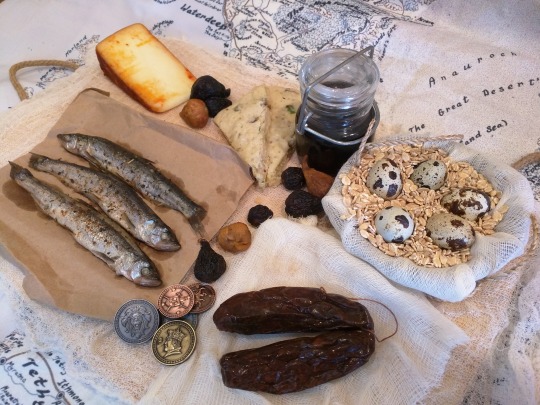
Pan fried Delimbyr smelt, spiced goat cheese (paprika crusted hand pressed Fontina), Gnome shortbread (savory pistachio), glass travel jar filled with Secomber Red (wine), hard boiled quail eggs packed in rolled oats (to keep safe), dried figs from Calimshan, and Southwood smoked goat sausage (blood sausage).
More images here. Discussion thread here.
Duergar (gray dwarves):
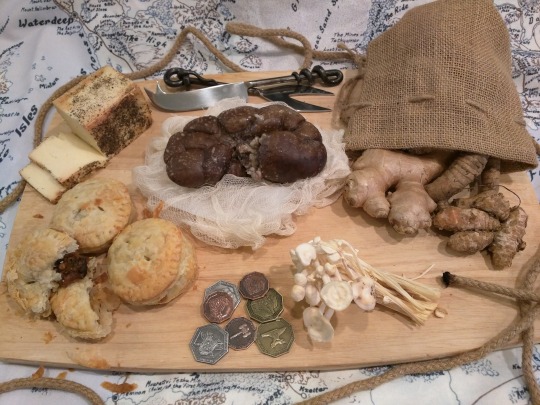
The Duergar (gray dwarves) are the hated subterranean cousins of the surface dwelling Shield dwarves. Vast Duergar kingdoms exist in the Underdark beneath Toril's surface. Duergar are known for their foul tempers, penchant for cruelty, grim and bitter dispositions. Their food is as coarse and uncouth as they are. Clockwise from top left: Sour Deep rothé pepper cheese (Limburger), boiled Deep rothé kidney (whole beef kidney), foraged roots and tubers; skirret and Fellroot (ginger and turmeric roots), contorted strangler fungus (Enoki mushrooms), onion & mushroom gravy hand pies (Morel mushroom with shallot and dill in cream sauce).
More images here. Discussion thread here.
Lizardfolk (This is a MEAL/feast and not a travel ration):
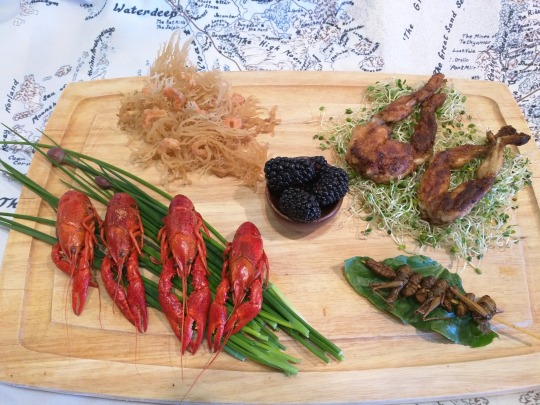
Lizardfolk are known to be omnivores, forage for a surprising variety of foods found within the confines of their marshy environs, in this case the Lizard Marsh near Daggerford. Fresh caught boiled Delimbyr Crayfish on wild chives, coastal carrageen moss entrapping estuary brine shrimp (irish moss, dried brine shrimp), Brackish-Berries (blackberries), Blackened Dart-Frog legs (frog legs) on spring sprouts (clover sprouts), roasted bog bugs on a stick!
More images here. Discussion thread here.
Drow (This is a MEAL/Party Fare and not a travel ration):

From top left: Menzoberranzan black truffle rothe cheese (Black Knight Tilsit), Donigarten Moss Snails (Escargot in shallot butter sauce), Blind cave fish caviar in mushroom caps (Lumpfish caviar), faerzress-infused duck egg imported from the surface Realms (Century egg), Black velvet ear fungus (Auricularia Black Fungus Mushroom).
More images here. Discussion thread here.
Svirfneblin (deep gnome) (This is a MEAL/Party Fare and not a travel ration):
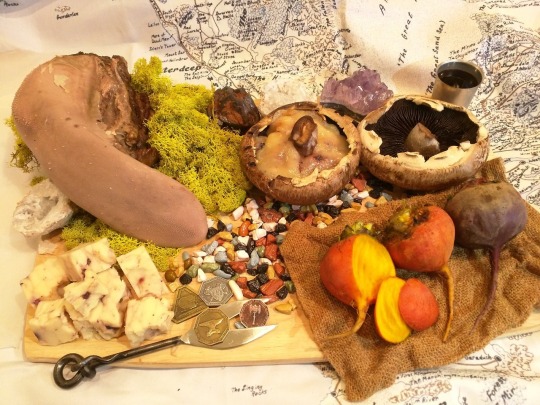
Underdark radishes, mushrooms and edible mosses. Rothé tongue (cow tongue) and rothé cheeses, which are made with wine to be eaten on the side as well as in plain varieties that can be melted into the mushroom caps.
More images here.
Mind Flayer/Illithid (This is a MEAL/Party Fare and not a travel ration):
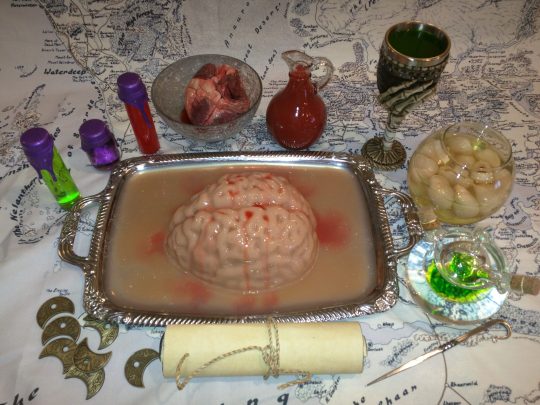
A Mind Flayer dwelling in the Underdark of the Forgotten Realms might celebrate a special event with a smorgasbord of illithid delicacies. Center: An extra large brain (former minotaur servant who did not go quietly) plated on tinged cerebrospinal fluid. Right: peeled kuo-toa eyeballs in serous fluid (with mithral eating pick) TOP RIGHT: green mushroom wine TOP: drow slave heart (tastes better than human) with savory sanguine sauce. All served amongst various potion bottles, scroll and alchemical vessel.
More images here. Discussion thread here. Some “making of” and reaction photos here.
Ogre Holiday Platter (This is a MEAL/Party Fare and not a travel ration):

Ogres are well known for legendary feats of horrendous brutality, torture, and savagery. It's no surprise they consider flayed skin, fingers, toes and ears (especially elf ears) as special delicacies. Ogres revel in the misery of others. Crushing the smaller races...then eating their crispy bits is considered a true perverse joy, worthy of what passes for brutal ogre celebration. Paired alongside campfire roasted rabbit and coarse grain bread.
Discussion thread here. More images here. ]]
#ooc#reference#cuisine#Forgotten Realms#d&d#dungeons & dragons#Pathfinder#dwarf#elf#halfling#half-orc#orc#gnome#lizardfolk#drow#long post#RPG rations#wats6831#duergar#Toril#Underdark#ogre
221K notes
·
View notes
Text
The expanded herb garden
Herbs
We forgot to discuss herbs. I am full up on lavender – 45 plants, a field. We will plant no more lavender on this property. It smells great and looks great. I cook with it occasionally, mostly with lamb, but it can be used with beef or pork just as you would use rosemary. Disappointingly, although the lavender is planted just yards in front of my bee hives, the honey bees showed no interest whatsoever in the lavender blossoms. No lavender flavored honey here. Too bad because I went through a phase of putting lavender into my coffee with honey, chilled and served over ice. It was very refreshing.
Rosemary and thyme never seem to survive the winter, or more precisely the spring thaw, in the herb garden, so maybe it’s time to start planting them, en masse, elsewhere. Who wouldn’t like to have a rosemary hedge, or a carpet of thyme? When I plant them this year I will give more careful consideration to where else they might thrive. We cook with them in almost every dish we eat for dinner. They go with all meats, and eggs, and beans, and mushrooms and soups. I never grow enough to harvest and dry it. Although, every other year or so I try to bring some indoors in a pot and the plants typically die by Valentine’s Day, on my kitchen counter.
The Egyptian walking onions can go back in the herb garden, but I ordered 30, so I can put some in the orchard, where they will be free to walk, and in the large bed on the front lawn where they will also have room to walk. They are an incredibly useful plant – the white roots and green stalks can substitute for scallions, while the topsetting bulbs can be used like shallots and the curling shoots on the topsetting bulbs are like garlic scraps.
As I mentioned previously, the chives are destined for the orchard. They tolerate shade so they can be planted close around the tree trunks, although these saplings won’t create much shade for a few years yet.
And a tarragon plant I had for several years did not survive transplanting, so I ordered a new one from Burpee. One plant is quite enough since we only ever use it in chicken salad or tuna salad.
Lovage. I’m sure I’ve mentioned it before. I planted some lovage (a perennial, cutting celery that is apparently more closely related to carrots) at least 10 years ago, in the herb bed, and it came back year after year. It is very strong tasting so it really only goes into soup. And this past summer I decided it is too tall (6 feet) to be growing so close to the house. It obstructs the view. So I divided it and moved it around. I’m waiting to see if it comes back this year in any of the places I transplanted it. It clearly does not need very good soil – the soil in the herb bed is rocky and full of clay. It is so resilient I feel obliged to grow it.
Mullein. Fuzzy Mullein is a medicinal weed. It is indestructible. I have seen it growing on railroad tracks. It is used to treat asthma and respiratory complaints. You can make tea from the blossoms. I just like the shape and texture. The first summer we moved into this house, in 2004, a single, stray mullein sprouted on the back edge of the property, just out of reach of the lawnmower. And the next year I found little mullein seedlings in the lawn nearby and moved them to safety in the flower bed. And ever since, I’ve been moving them around, culminating in a giant mullein I settled in the great hugel in 2019 which in 2020 grew to a 4 foot in diameter, rosette of green velvet leaves that put up an 8 foot flower stalk as thick as my wrist. They are so hardy and dramatic looking there will always be room for plenty of them in my yard.
Oregano is everywhere now, as is the lemon balm. Ironically, we rarely use either in cooking, even the oregano because we have a large container of dried oregano that just never runs out. But, also ironically, the honey bees really like the blossoms on both of these plants, and these plants bloom more than once per season. I am suspicious that, even though the articles I’ve read say bees are attracted to the color blue, honeybees prefer white or green blossoms to anything else.
Cilantro and borage are two annual herbs I never have to plant again. They self-seed and come back every year, all over the place. I’m not one of the 4-14% of the general population to whom cilantro tastes like soap. Cilantro is one of those few tastes that I did not grow up with and therefore have a very clear memory of the first time I ever tasted it. It was a totally new and unique taste and I really liked it. It tasted effervescent and fresh and it tastes like the color green. It has to be eaten raw. Borage is a cucumber flavored herb that also has to be eaten raw, but also very young because it develops spines. If it flowers, pretty little blue, star-shaped blossom clusters, then the leaves are too stiff and prickly to eat. But the blossoms are edible and have the same great flavor, and look nice in salads or as garnish.
I’ve been rather unsuccessfully growing mint all these years. It is a weed and it really should flourish. But in 2014 it died out entirely from a black spot fungus that infested the shade side of the herb garden. I had to treat the soil with neem oil for several years to be rid of the fungus. Now, as a precaution, I bury any penny minted before 1976 (because the old ones were totally copper and copper spray is a cure for lots of plant funguses) in the shaded herb bed. The past few years I have replanted the mint, along the patio wall where it has limped along. And then, this past summer I found it is growing wild in the left back corner of my property, at the edge of the great hugel.
I have two large clumps of hyssop in the hugel already, so no need for more of that. It has great, purple blossoms all summer long, the bumblebees love it, and the honey bees ignore it. It is “Anise” Hyssop but I have never yet attempted to eat it. I think it is used for tea.
Milk thistle is also happily established in the hugel and I will have to watch it and make sure it does not spread. I originally planted it because it has a large taproot that can be roasted like a vegetable, but I have not yet tried to eat it. It is very pretty, about a foot high with distinctive holly-like, green and white striped leaves, and a purple bloom.
I’m trying to overwinter the parsley in the garden, and I even have a row of root parsley (which has a strong taproot that grows to the size of a small carrot) overwintering – parsley is a biannual. We eat lots of it. It goes into a lot of dishes, but I also like making chimichurri sauce, which is parsley pesto with lots more garlic. It goes well on grilled chicken or steak.
Sage is a hardier than rosemary and thyme. It lasts 3-4 years in the herb garden but is always small. So this year I will plant two patches in the hugel.
Nasturtiums, of course, are in my top five all-time favorite plants to grow. The leaves and blossoms are edible. It has a fresh peppery flavor but also a succulence. The plants are excellent companion for lots of different vegetables and I plant them everywhere.
Have I babbled about basil? I have discovered that basil does best in part sun part shade. It can be heat sensitive and needs water. That is why it is recommended to plant it under tomato plants. There are so many types of basil to choose from. I like purple basil. It has a stronger smell than green basil. I like Thai basil; it has a stronger, more licorice flavor and stands up to heat (both BTUs and Scovilles) better. I like lettuce leaf basil, with leaves like bib lettuce, big enough to wrap cheese and bruschetta into basil leaf tacos. And then there is holy basil, an herb used more medicinally, in tea. It has a stronger, smokier flavor, like the lapsang souchong of basils. So, which basil did I choose? Choose? Trick question -there is no choosing. They each have a completely different use, so I have to have them all!
And from the boundless basil, we will now digress into pure flights of fancy.
Green ginger, that’s its nickname. Its proper name is wormwood. It is used to create absinthe (no idea how and no intention of attempting it). But it is flowering perennial – “feathery grey-green foliage and bright yellow flowers” - so into the great hugel it goes. It is supposed to be quite bitter raw, and it is suggested that it be used in aromatic bitters. Medicinal qualities are dubious. Most articles insist that it is NOT a hallucinogenic, and that it IS somewhat of an anti-inflammatory.
Angelica, a biannual that looks a bit like Queen Anne’s Lace, but with a thick, celery-like stalk, and in fact is a member of the celery family. It likes total shade. It reportedly has medicinal qualities; the Chinese variety of it is known as Dong Quai (Angelica sinensis), a stimulant. I’m not getting that variety. I am planting Angelica archangelica (Holy Ghost), of Norwegian origin. It is another purported anti-inflammatory, anti-fungal. I have grown it in the past just to fill up shady spots. But I have not yet eaten it. Its flavor has been likened to juniper berries. It is suggested to be used to: “flavor fish, poultry, cooked fruits, soups, or stews, while its stems can be cut and prepared like asparagus, chopped and stewed with rhubarb and apples, minced in preserves and marmalade, or candied”.
Anise. Why, since I have anise hyssop, would I need to grow anise? It is yet another member of the carrot-celery-parsley family. Medicinally, it sounds a lot less dubious than some others. It contains manganese and iron. It is anti-fungal/anti-bacterial. It sooths and prevents stomach ulcers. It is an anti-inflammatory. And it is a tasty spice used in sweets and pastries. Right now, I like crushed anise seeds on top of my expresso or cappuccino. Anise Hyssop is more bitter and smokier/menthol tasting, more suited for tea.
Fenugreek. This is a new one that I encountered at our farmer’s market this summer. I ended up stir-frying it like an Italian escarole/broccoli rabe, and stewing it in a curry sauce like spinach. It’s sort of the texture of spinach and, although it is supposed to be slightly sweet and nutty in taste, I found it to be like a mildly bitter oregano. In theory the seeds taste like maple syrup. Medicinally, it is purported to lower blood sugar and cholesterol and help skin conditions. It belongs to the bean family of plants.
Caper bush. Capparis spinose is the blooming bush commonly called “Flinders Rose”, which is interesting because caper berries look a lot like large rose hips. You typically eat the flower buds pickled. The plant is a perennial that belongs in a rock garden. It is also a hybrid of several other distinct species in its family. It belongs to the Brassicales order of plants, and is related to mustard and cabbage plants. There are no known medicinal properties. It’s perennial, so hopefully I only have to plant it once. It tolerates poor soil and drought so it can be planted where a lot of things can’t. We cook with capers regularly. I have even pickled nasturtium buds as a substitute, so I’m very interested in the real capers. And I like pickled caper berries in my martinis.
Sesame. I like tahini. I like sesame seeds toasted and sprinkled on yogurt. A flowering plant first domesticated on the sub-continent of India, it is the world’s oldest seed-oil crop. It purportedly can lower blood pressure. It is an annual that prefers dry, hot weather. So I will plant it in the raised garden bed this year. An added advantage of that location is that it is close to the bee hives, and the flowers of the sesame plant are supposed to be very attractive to honey bees specifically. I have doubts, since the pictures I have seen all show big, tubular flowers that are purple. I think they are going to be more attractive to bumble bees than to honey bees.
Black Cumin. Otherwise known as Black Seed, it is rumored to have almost as many miraculous health benefits as marijuana. But none of those claims are scientifically proven. But then again, no financial interests are served by promoting naturally existing medicines that can’t be patented and sold for lots of money. I just eat the seeds for their flavor. I like toasted cumin seeds on melted cheese, in my cereal, and on buttered toast. There are two different plants referred to as “black cumin”. I am planting Nigella sativa. It is a member of the buttercup family along with delphiniums, clematis and hellebors. This is a historical spice – seeds were found in a Hitite(!) flask in Turkey dating to 2000 BC. It is a flowering annual sometimes called “Love in the Mist” and the plant looks a lot like dill or comos to me. It is quick growing and is advised to be sown every three weeks mid April through mid June, and then again August 15 and September 15 for continual bloom. I think I’m more interested in a consolidated, early harvest and maybe a second fall planting to allow it to self seed for next year.
Feverfew. Also a member of the aster family, but much prettier, and more compact. Someone in my garden swap group traded me a feverfew for some mullein last summer. It was lovely (coin sized, white, daisy like flowers) and the honey bees liked it. Supposedly it will self-seed. So I’m waiting to see if it comes back. It is used medicinally to treat migraine headaches. I don’t suffer those so for me it is purely ornamental (and pollinator friendly). Maybe it ends up in my honey and adds to the relief from pollen allergies by adding head-ache relief.
Crocus. A flower, yes, but I bought the giant fall blooming variety from which the stamens are harvested (with tweezers) and dried into saffron. We use it in risotto and paella. And this time, I carefully planted it in the orchard, unlike the hundreds of crocus I have planted in my front lawn that spring up every spring only to be eaten and re-eaten by deer any time they get taller than an inch. And because they are fall blooming I am concerned about avoiding planting over them in the spring, or letting weeds completely overtake the spots where I planted them, so with each clump of 10 crocus bulbs I planted one, large daffodil bulb so I will have a daffodil flag marking each spot in the spring that I can replace with a permanent marker in the summer.
French Sorrel: I have two large, perennial patches of it, but other than the first, tender, spring leaves, it is fit for nothing but soup; I must resist the temptation to add it to salad
And, of course, I forgot to mention a couple of additional herbs I decided to grow. I really do not wish to make my own medicines, so there are some heavy weight medicinal herbs I’m NOT growing. But there are a couple more culinary herbs I am going to attempt to grow - attempt is the operative word because they are annual and tropical.
Culantro - not to be confused with Cilantro (soapy tasting, Mexican parsley). Culantro looks like dandelion leaves, grows in a rosette and supposedly tastes like a mix of sorrel, cilantro and arugula. It is biannual and pungent enough to stand up to high heat cooking and stewing, whereas cilantro is used raw or just to finish or garnish a dish. Culantro figures in Vietnamese and Cuban cooking and pairs well with dishes that include beef.
Roselle - is Indian Hibiscus. It’s perennial in the tropics. It grows 4 feet high. The stems can be used as a jute substitute in burlap or rugs. The buds and flowers can be used as a natural red food coloring or dye, they have a sweet and sour flavor and are used to make chutney and a wide variety of hot and cold beverages. The leaves are cooked and eaten as a spicy, peppery spinach. They hold up well to heat and are used in curry dishes and to season bean dishes.
Shiso - is that flat, basil like leaf with a serrated edge that often appears as a garnish in your sushi order. It has a very delicate cucumber, lemon and licorice flavor. Excellent with raw or cooked fish. A relative of mint and basil, it is suggested you can substitute it into any cocktail that calls for mint. Doesn’t hold up to heat so well. You can blend it for salad dressing, or dipping sauce for tempura, and you can make raw shiso pesto to serve over fish.
0 notes
Text
Someone Laughs, Someone Cries
Jessica had never seen anything like this in her life. A mossy green stone under the ceaseless flow of a clear stream, she’d never seen anything like this in her life. So green, so soft; like velvet corduroy. She wanted to lay in it. She wanted to get a tiny hammock and lay in it. So soft. Like a field that stretched into the sunset. It was like one of those nights when she would lay out in the field with a starry night overhead promising a bigger tomorrow. She thought on the clouds and the moon, the stars and their patterns. She loved smell of the night, the cold incomprehensibility of dreams. Her boyfriend would never understand because he never did. But here with this moss she felt as free as the Sun. As free as all those little Suns with their little planets that she loved so dearly. More free; she felt as free as the one that thought it all into being. She knew what she was meant to do, she had been there before. The stars called her name, and she thirsted for them like a baby for milk. And as she stared at this stone, covered in the beautiful moss of tomorrow, she had completely forgotten about Daniel. The cold creek flowed smooth over his ankles. The first step was the worst but after that the draft between his toes meant nothing but comfort. It ebbed over the top and under the bottom of his feet with a soothing chill. As he stared at the stone the moss reached out and grabbed him. He wrestled with it. It took him down, inch by inch, into the nothingness of its pigment. Lost in a sea of green and hungry for oxygen he became lost in the unreality of his demise. The present brought forth the past as he awoke on a Sunday morning to the smell of fresh cinnamon rolls. As he rose and proceeded down his stairs, he knew the rolls would be a final pleasure; yet still he approached. The sweet promise of a means to and end tasted like baked sugar and everyone knows that Daniel has a sweet tooth. The pan burned with anticipation but his family missed the death in his eyes as he reached for the final syrupy biscuit, taking it in his hand and swallowing it whole while closing his eyes because for the first time in memory he was beginning to smile. The last few air bubbles screamed for the surface when Daniel gave in and allowed himself to be taken over. Fading into fungus felt like becoming pure pink, inside and out. The moss wanted all of him and proceeded to take it. And as he snapped out of it, Daniel found his laughter at the silliness of daydreaming interrupted by Jessica’s tears.
0 notes
Photo

Maine shroomies!!! Let’s see, 1,2,3, we have monotropa uniforma, or ghost flower!!! I was soooo excited to fine this one! We have them in Kentucky, but I’d never run across one (thanks @todd.forsgren for the I.d.) 4,5,6, is I think a russula cyanoxantha, or charcoal burner, 7,8 is I think sclerodermataceae (mouth full) or common earth ball, 9,10 is I think phaeolus schweinitzii, or velvet-top fungus!!! So thankful for the rain the day before because I knew I could go mushroom gazing! . . . #mushrooms #mushroom #mushroomsofinstagram #mushroomhunting #mycology #mycologysociety #mycologymonday #mycologyclub #mycologyphotography #mycologylife #Maine #mainelife #forest #forestphotography #forestbathing #getoutside #goexplore (at Macmahan, Maine) https://www.instagram.com/p/CEjXztMlZ43/?igshid=11xsf6twwzky
#mushrooms#mushroom#mushroomsofinstagram#mushroomhunting#mycology#mycologysociety#mycologymonday#mycologyclub#mycologyphotography#mycologylife#maine#mainelife#forest#forestphotography#forestbathing#getoutside#goexplore
0 notes